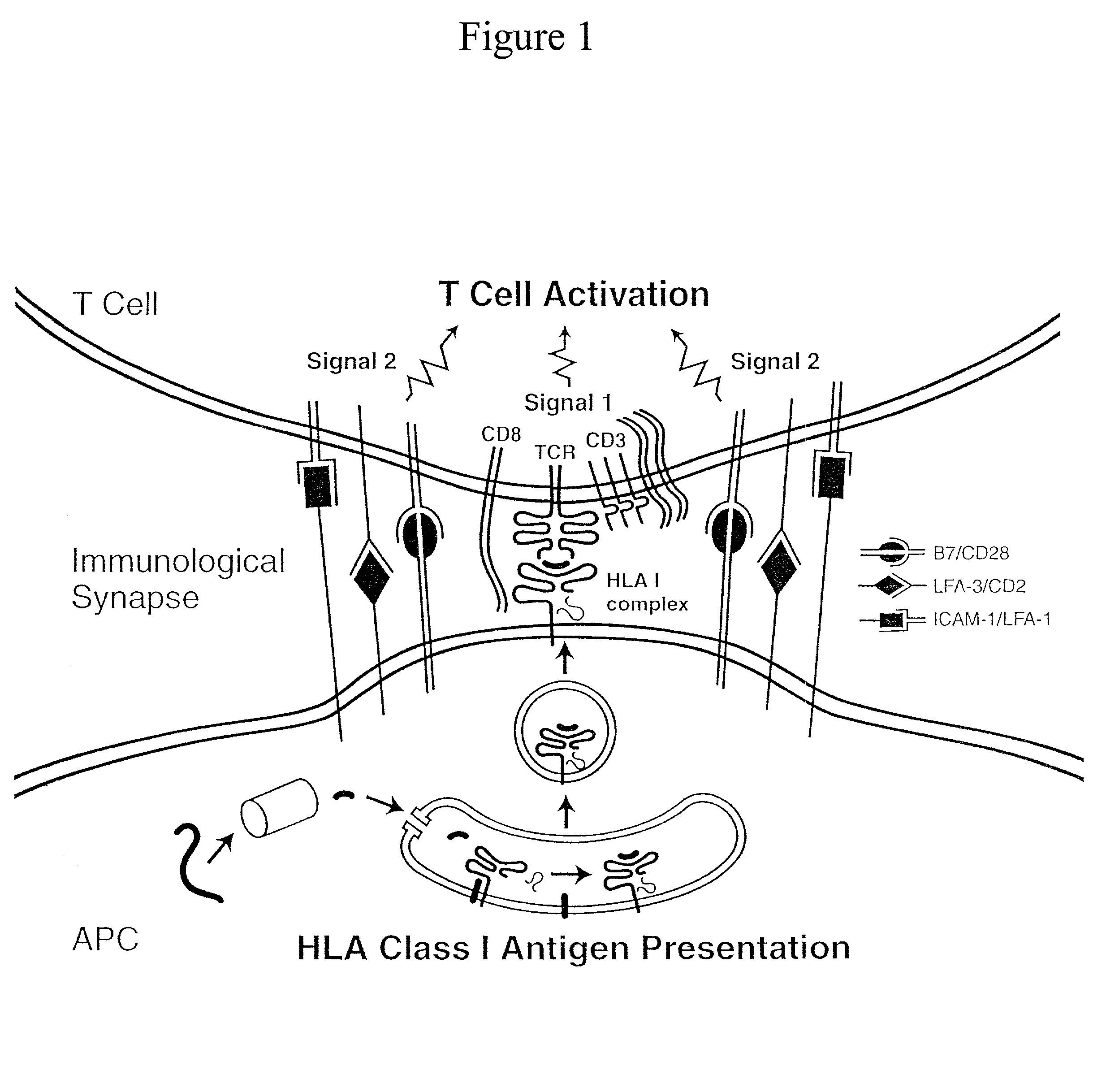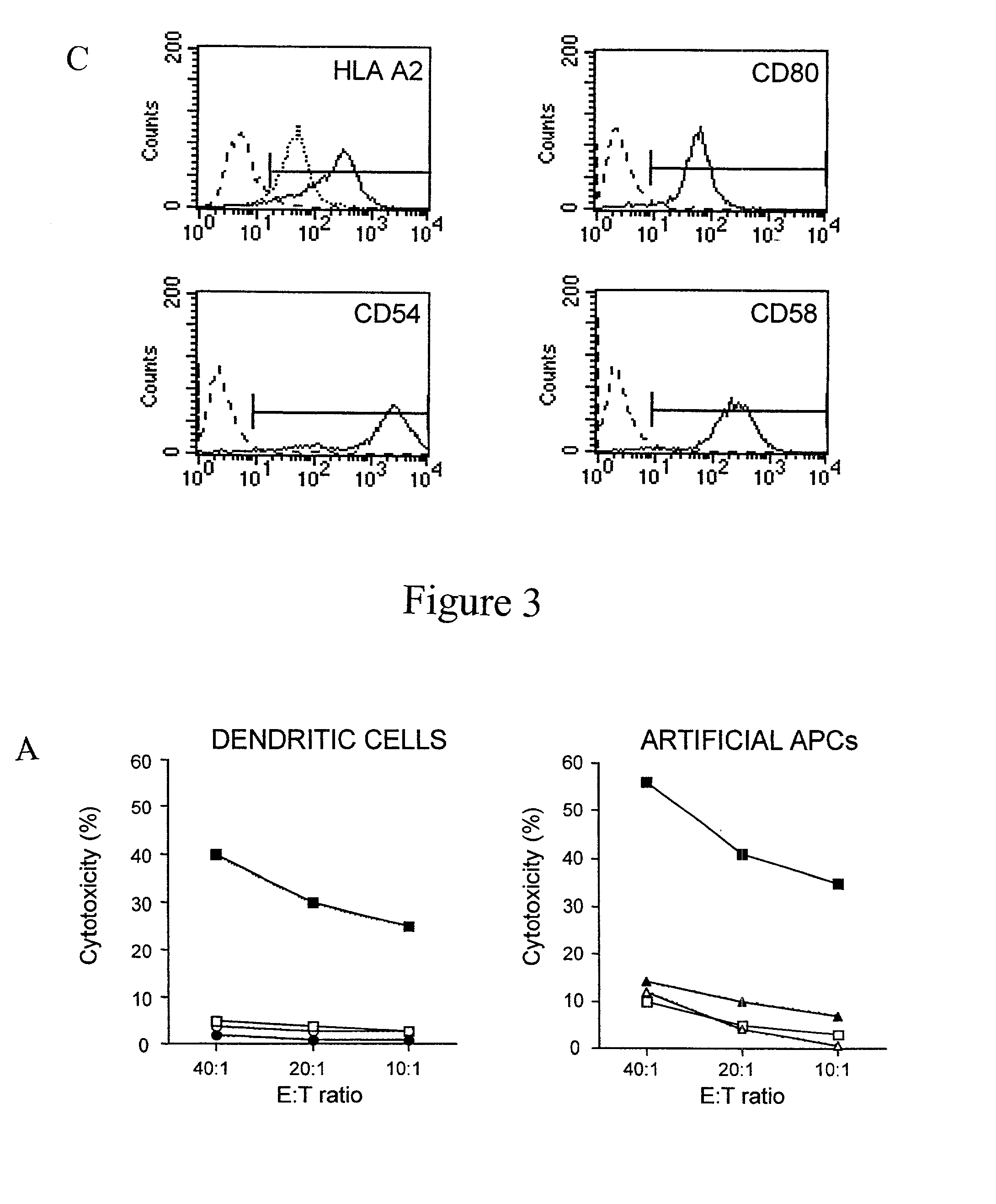Artificial antigen presenting cells and methods of use thereof
a technology of artificial antigen and presenting cells, which is applied in the field of artificial antigen presenting cells, can solve the problems of unable to produce autologous t cells, few human populations have been hla-typed adequately, and subsequent tumor rejection, so as to reduce the risk or the rate of progression, high tumor burden, and palliative
- Summary
- Abstract
- Description
- Claims
- Application Information
AI Technical Summary
Benefits of technology
Problems solved by technology
Method used
Image
Examples
example 2
Gene Transfer Procedures
[0119] 293GPG packaging cells (Ory et al. (1996) Proc. Natl. Acad. Sci. USA 93:11400-11406) were transfected with each plasmid by CaCl.sub.2 as described in Riviere and Sadelain, in, Gene therapy protocols (ed. Robbins) pp. 59-78 (Humana Press, Totowa, N.J., (1997). A total of 5.times.10.sup.4 NIH 3T3 cells (ATCC) were plated in a 6 cm plate and cultured in Dulbecco's modified Eagle medium (DMEM; Mediatech, Hermdon, Va.) with 10% heat-inactivated donor calf serum (DCS; Hyclone, Logan, UT), penicillin at 100 U ml.sup.-1, and streptomycin at 100 .mu.g ml.sup.-1. They were infected the day after with cell-free retroviral supernatant (0.45 .mu.m filtration, Acrodisc; Pall Corporation, Ann Arbor, Mich.) in the presence of polybrene (Sigma, St. Louis, Mo.) at 8 .mu.g ml.sup.-1for 16 h.
[0120] Geneticin (Sigma) was added at 1.2 mg ml.sup.-1 to the medium for two weeks to select the cells expressing A2.1. Puromycin (Sigma) was added at 3 .mu.g ml.sup.-1 to the medium ...
example 3
Generation of DCs and T Cell Purification
[0121] Peripheral blood was obtained from normal HLA A2.1.sup.+ donors in heparinized tubes. HLA typing was performed by PCR in the HLA laboratory at MSKCC. Peripheral blood mononuclear cells (PBMC) were isolated by density gradient centrifugation on lymphocyte separation medium (Accurate Chemical & Scientific Corporation, Westbury, N.Y.). Dendritic cells were generated as described. Bender et al. (1996) J. Immunol. Met. 196:121-135; and Romani et al. (1996).
[0122] Briefly, the T cell-depleted (ER.sup.-) population was prepared by rosetting with sheep red blood cells (Colorado Serum Company, Denver, Co.). O'Doherty et al. (1993). Two million ER.sup.- cells were plated per well in six-well plates. GM-CSF (Immunex, Seattle, Wash.) and IL-4 (R&D Systems, Minneapolis, Minn.) were added at 1,000 U ml.sup.-1 every second day for eight days. Conditioned medium (CM) was prepared by adding 50.times.10.sup.6 ER.sup.- cells on Petri dishes coated with h...
example 4
Flow Cytometry Analysis
[0124] To analyze the phenotype of the AAPCs, we used antibodies against human .beta.2-microglobulin, A2.1 (kind gifts of Dr. S. Y. Young), B7.1 (Pharmingen), ICAM-1, and LFA-3 (Becton Dickinson). Anti-CD14, CD80, CD40, HLA DR (Becton Dickinson), and anti-CD83 (Immunex, Marseilles, France) antibodies were used to evaluate the level of maturation of the DCs. To verify the purity of the preparations of T cells and to study the phenotype of these T cells, we stained cells with antibodies anti-CD19, CD14, CD56, CD16, CD3, CD4, CD8, CD25, CD69, and HLA DR (Becton Dickinson).
PUM
| Property | Measurement | Unit |
|---|---|---|
| Fraction | aaaaa | aaaaa |
| Length | aaaaa | aaaaa |
| Time | aaaaa | aaaaa |
Abstract
Description
Claims
Application Information
 Login to View More
Login to View More - R&D
- Intellectual Property
- Life Sciences
- Materials
- Tech Scout
- Unparalleled Data Quality
- Higher Quality Content
- 60% Fewer Hallucinations
Browse by: Latest US Patents, China's latest patents, Technical Efficacy Thesaurus, Application Domain, Technology Topic, Popular Technical Reports.
© 2025 PatSnap. All rights reserved.Legal|Privacy policy|Modern Slavery Act Transparency Statement|Sitemap|About US| Contact US: help@patsnap.com



